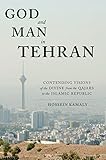God and Man in Tehran : Contending Visions of the Divine from the Qajars to the Islamic Republic / Hossein Kamaly.
Material type: TextPublisher: New York, NY : Columbia University Press, [2018]Copyright date: ©2018Description: 1 online resourceContent type:
TextPublisher: New York, NY : Columbia University Press, [2018]Copyright date: ©2018Description: 1 online resourceContent type: - 9780231176828
- 9780231541084
- 202/.11095525 23
- BP166.2 .K225 2017eb
- online - DeGruyter
- Issued also in print.
| Item type | Current library | Call number | URL | Status | Notes | Barcode | |
|---|---|---|---|---|---|---|---|
 eBook
eBook
|
Biblioteca "Angelicum" Pont. Univ. S.Tommaso d'Aquino Nuvola online | online - DeGruyter (Browse shelf(Opens below)) | Online access | Not for loan (Accesso limitato) | Accesso per gli utenti autorizzati / Access for authorized users | (dgr)9780231541084 |
Frontmatter -- Contents -- Preface -- Acknowledgments -- On Transliteration and Dates -- ONE. O God, O Heaven, O Nature -- TWO. Mediatory Theology and Its Discontents -- THREE. God with Us -- FOUR. The Law: God's and Man's -- FIVE. Falsafeh and the Madraseh -- SIX. Sufism Returns, and with a Vengeance -- SEVEN. Varieties of Skeptical Expression -- Appendix -- Notes -- References -- Index
restricted access online access with authorization star
http://purl.org/coar/access_right/c_16ec
In God and Man in Tehran, Hossein Kamaly explores the historical processes that have made and unmade contending visions of God in Iran's capital throughout the past two hundred years. Kamaly examines how ideas of God have been mobilized, contested, and transformed, emphasizing how notions of the divine have given shape to and in turn have been shaped by divergent conceptualizations of nature, reason, law, morality, and authority.God and Man in Tehran analyzes official government policies, modern textbooks, and university curricula; popular beliefs and ritual practices; and philosophical and juridical attitudes toward theological questions in traditional institutions. Kamaly considers continuity and change in religiosity under the Qajar and Pahlavi dynasties; the significance of outbreaks of messianic expectations; why a modernizing nation took a sudden turn toward state religiosity; and how the Islamic Republic deploys visions of God against foreign enemies and domestic critics. Beyond the majority Shia Muslim population, the book includes minority and suppressed voices, discussing the views of Sunni Muslims, Armenian and Assyrian Christians, Jews, Bahais, and Zoroastrians and investigating issues of gender and class. With a focus on the diversity of ideas of the divine, God and Man in Tehran offers a novel perspective on the intellectual movements that have shaped Iranian modernity.
Issued also in print.
Mode of access: Internet via World Wide Web.
In English.
Description based on online resource; title from PDF title page (publisher's Web site, viewed 29. Mrz 2022)


